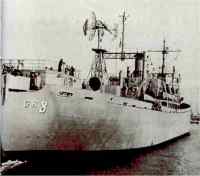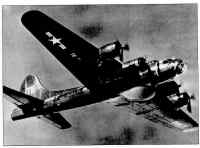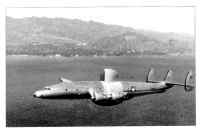

The DER were organized into 2 EsCORT SquadRONs: for each coastline: CORTRON 16 and 18 over Atlantic with base at Newport, CORTRON 5 and 7 over Pacific, based at Seattle, WA and Pearl Harbour, HI: Over the Contiguous Barrier the DER were replaced by class "Guardian" AGR (Radar Picket Ships): these were "Liberty" cargo ships transformed between 1957 and 1959 by the Philadelphia, Norfolk, Portsmouth and Charleston shipyards. AGR were over 134 m long and with a displacement of 10,750 tons at full load, a crew of 13-20 officers and 138-150 enlisted, that, thanks to the boat dimensions, could have more comfortable room than aboard the little DER.

The new units were designed YAGR (Ocean Radar Station Ships), the name was then changed in AGR. These units
were equipped with the big AN/APS-17 discovery radar, a radar for altitude
definition, a TACAN, a ESM (Electronic Support Measures), for electronic
surveillance, and various communication systems. Into the hull there was
a wide CIS (Combat Information Center), with vertical plotting boards. The
armament was made by 2 Mark 22 3" guns and various 12.7 mm machine
guns.
The 16 AGRs were spread among two fleets: on the Atlantic Contiguous Barrier
operated RADRON 2 (RADar SquadRON Surveillance 2), initially
based at Newport, an then, from September 1958, at Davisville, RH. RADRON
1, based at San Francisco, patrolled the Pacific Contiguous Barrier. The
patrols lasted 3-4 weeks over Atlantic and 4-5 weeks over Pacific.
(see also http://yagrs.tripod.com fo further details)

US Navy acquired in 1945 24 B-17G
Boeing bombers. Many of them, brand new, came from Long Beach Douglas
plant: they were transformed at Naval Aircraft Modification Unit, in Pennsylvania
into PB-1W,
for radar patrolling purposes. The first aircraft equipped with APS-20
radar was assigned to VPB101 on April 1946: 31 aircraft entered in service.
During late 1946, VPB101 moved at NAS
Quonset Point, RH, being redesigned VX4 (AEW Development Squadron
Four), and, during July 1948, it reached its final destination at NAS
Patuxent River, ML. This station will become the nest of Navy Early
Warning squadrons.
During 1952 VX4 became VW2, and, in the same year, was established at
NAS Barbers
Point, HI, a second squadron with 4 PB-1W, named VW1. Although they
were limited by an unpressurized cabin, PB-1Ws had an excellent service.
During 1949 will fly PO-1W (based upon Lockheed 749 'Constellation') that
paved the way to the development of typical American radar picket, until
the upcoming of E-3 AWACS: the WV-2 (initially
designed PO-2W), based upon L-1049G Super Constellation.
The first Wv-2 entered service with US Navy during 1954. WV-2s equipped
VW11 and VW15 during 1955, both based at Patuxent River with AEW Training
Unit Atlantic. Each squadron had 100 officers and 500 enlisted, with 12
complete crews made of 26 men.
35 meters long and with a maximum take-off weight of 70 tons, WV-2 had
a maximum speed of 530 km/h and a range of 6200 km. The big belly radome
housed the usual APS-20 radar with a range of 460 km, while the dorsal
radome fitted the APS-45 antenna, for the target altitude calculation.
Data streamed to the plotting screens of the onboard CIC (Combat Information
Center).

WV-2, officially named 'Warning
Star', but nicknamed by crews 'Willie
Victor', was an extremely complex machine, and its hydraulic and electric
circuits were a continuous source of problems. To keep two aircraft in flight,
a line of 9 aircrafts were necessary. For this reason, the Navy acquired
142 of these airplanes.
In a standard picket mission, the WV-2 had a crew of 26 plus commander:
2 pilots, 2 navigators, 2 CIC controllers, 12 radar operators, 2 electronic
war systems operators, 2 engineers, 2 radio operators, 2 electronic technicians
for maintenance operations. These 27 men was spread over 2 turns, 3-4 hours
long, with the exception of radar operator that was replaced every 45 minutes
in order to keep high his level of attention. CIC operators tried to identify
targets from sea and from air, they could also guide the fighters during
interception missions. The aircraft was linked to land bases via Morse signals
and HF and UHF radio. HF and UHF was used for communication with ships and
other aircrafts as well.

From 1954 to 1962 the defense was also based upon "ZPG-2W" and "ZPG-3W" blimps. 5 "ZPG-2W", manufactured by Goodyear, mounted the APS-20 search radar into the APS-69 antenna radome. The "ZPG-2W" had a crew of 21 and a range of 200 hours. The ZPG-3W entered service in 1959, were 122.83 meters long, and mounted the search antenna into the helium chamber, the altitude radar was mounted over the envelope, whose volume was 1,465,000 cu.ft. The blimps were assigned to ZW1 (Airship Airborne Early Warning Squadron One), based at NAS Lakehurst,NJ, and were used at station 6 of Inshore Barrier. Their range laid between the DERs over Contiguous Barrier and the land based radars over the New Jersey coastline. The usage of blimps was obstacled by the imposed flight time limits, in contrast with the blimp capabilities that would allow more prolonged missions. In July 1959, the Navy rejected the CINCNORAD (Commander in Chief, NORAD) request to detach ZW-1 at San Diego, to improve radar coverage of Southern California: an absurd operation, because San Diego base was not fitted with the necessary support structures. During October, 1961, the last blimp was decommissioned, but 2 ZPG-3W survived for research purposes at NAS Lakehurst until August 1962.
| disclaimer | |
|
page modified |
|
|
